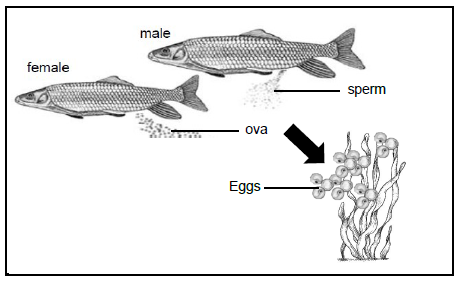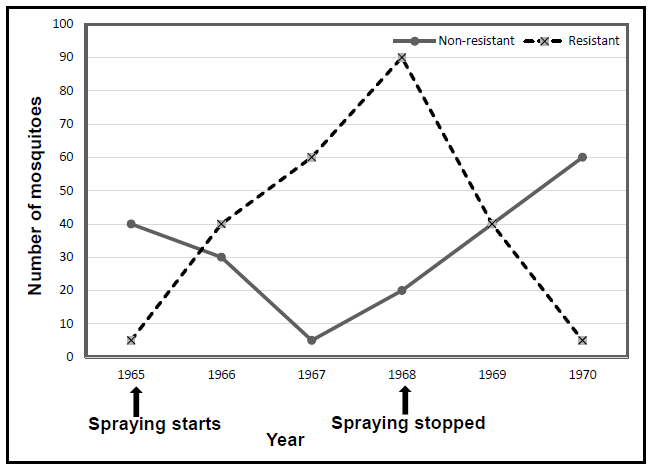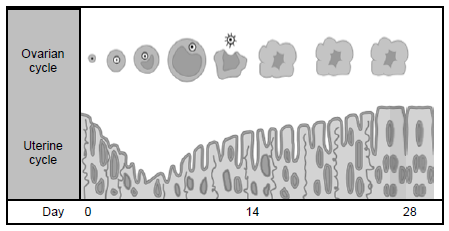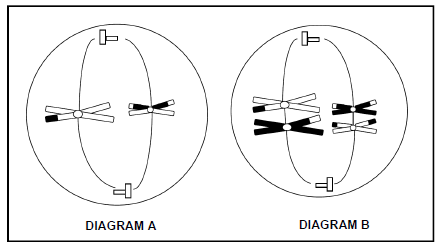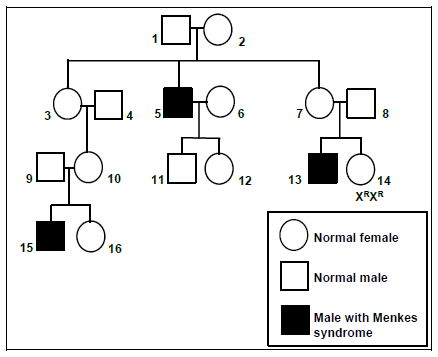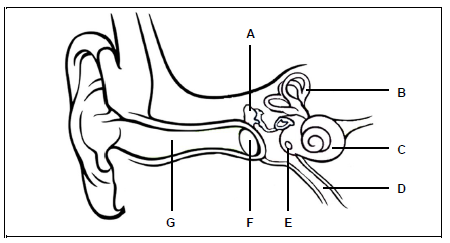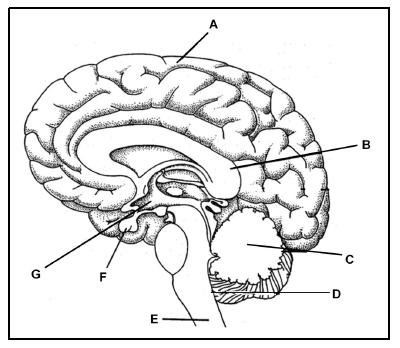LIFE SCIENCES with Memorandum - 2024 Grade 12 June Common Exams
Share via Whatsapp Join our WhatsApp Group Join our Telegram GroupMARKS: 150
TIME: 2½ hours
INSTRUCTIONS AND INFORMATION
Read the following instructions carefully before answering the questions.
- Answer ALL the questions.
- Write ALL the answers in the ANSWER BOOK.
- Start the answers to EACH question at the top of a NEW page.
- Number the answers correctly according to the numbering system used in this question paper.
- Present your answers according to the instructions of each question.
- ALL drawings MUST be done in pencil and labelled in blue or black ink.
- Draw diagrams, tables or flow charts ONLY when asked to do so.
- The diagrams in this question paper are NOT necessarily drawn to scale.
- Do NOT use graph paper.
- You must use a non-programmable calculator, protractor and a compass, where necessary.
- All calculations to be rounded off to TWO decimal spaces.
- Write neatly and legibly.
SECTION A
QUESTION 1
1.1 Various options are provided as possible answers to the following questions. Choose the correct answer and write only the letter (A–D) next to the question numbers (1.1.1 to 1.1.10) in the ANSWER BOOK, for example 1.1.11 D.
1.1.1 Cells that can differentiate into any type of cells are called …
A sex cells.
B daughter cells.
C stem cells.
D haploid cells.
1.1.2 Which ONE of the following processes is responsible for the production of male gametes?
A Spermatogenesis
B Oogenesis
C Ejaculation
D Ovulation
1.1.3 The diagram below shows a male and female fish during reproduction. The female fish releases hundreds of ova into the water. The male fish swims close by and releases his sperm over the eggs. The fertilised eggs attach to water plants.
The reproductive strategies represented above are …
A external fertilisation and vivipary.
B precocial development and ovovivipary.
C internal fertilisation and ovipary.
D external fertilisation and ovipary.
1.1.4 The function of the chorion in the amniotic egg is to ...
A allow for gaseous exchange in the egg.
B control temperature in the egg.
C provide nutrients for the developing embryo.
D collect nitrogenous waste from for the developing embryo.
1.1.5 The table below shows the anti-codons of tRNA that code for different amino acids found in human protein.
ANTI-CODONS OF tRNA | AMINO ACIDS |
CAA | Valine |
CCC | Glycine |
CGU | Alanine |
AAA | Phenylalanine |
UCG | Asparagine |
UAC | Methionine |
GGU | Proline |
AGC | Tryptophan |
UCA | Serine |
What is the corresponding amino acid for the DNA base triplet TCG?
A Alanine
B Tryptophan
C Serine
D Asparagine
1.1.6 The diagram below represents three phases of meiosis.
The correct order of the phases is …
A 1, 2 and 3.
B 2, 3 and 1.
C 1, 3 and 2.
D 2, 1 and 3.
1.1.7 The peripheral nervous system is made up of …
A motor and sensory neurons.
B sympathetic and parasympathetic nervous systems.
C cranial and spinal nerves.
D connector neurons.
QUESTIONS 1.1.8 AND 1.1.9 REFER TO THE INFORMATION BELOW.
In pea plants, yellow seed colour (Y) is dominant over green seed colour (y). Smooth seed texture (S) is dominant over wrinkled seed texture (s). A student crossed a plant which had yellow wrinkled seeds with a plant which had green smooth seeds.
1.1.8 Which ONE of the following shows possible alleles present in a gamete that is produced by the plant with yellow wrinkled seeds?
A YYss
B yySS
C yS
D Ys
1.1.9 Which ONE of the following is a possible representation of the genotypes of the P1 generation?
A YYSS x yyss
B Yyss x yySs
C YYSS x yySs
D Yyss x YySs
1.1.10 Which ONE of the following monohybrid crosses will result in a phenotypic ratio of 1 : 1? A cross where …
A both parents are heterozygous.
B one parent is heterozygous and the other parent is homozygous dominant.
C one parent is heterozygous and the other parent is homozygous recessive.
D both parents are homozygous for the dominant characteristic. (10 x 2) (20)
1.2 Give the correct biological term for EACH of the following descriptions. Write only the term next to the question numbers (1.2.1 to 1.2.10) in the ANSWER BOOK.
1.2.1 A genetic disorder characterised by the absence of a blood-clotting factor
1.2.2 The phase of meiosis during which homologous chromosomes separate and start moving towards opposite poles
1.2.3 The defect in cell division that leads to Down syndrome
1.2.4 The structure that is made up of chromatids joined by a centromere
1.2.5 The structure in the cell responsible for producing spindle fibres during meiosis
1.2.6 A disease characterised by the breaking down of the myelin sheath
1.2.7 An eye defect caused when the lens cannot flatten enough to focus the light on the retina
1.2.8 The structure that conducts the nerve impulse from the cochlea to the cerebrum
1.2.9 The hormone responsible for female secondary characteristics
1.2.10 The fluid responsible for controlling the temperature of the developing human foetus (10 x 1) (10)
1.3 Indicate whether each of the descriptions in COLUMN Ι, applies to A ONLY, B ONLY, BOTH A and B, or NONE of the items in COLUMN ΙΙ. Write A only, B only, both A and B, or none next to the question numbers (1.3.1 to 1.3.3) in the ANSWER BOOK.
COLUMN Ι | COLUMN ΙΙ | ||
1.3.1 | Crossing over | A: B: | Genetic variation Increase in number of chromatids |
1.3.2 | Hypothalamus | A: B: | Controls breathing Controls temperature |
1.3.3 | Progesterone | A: B: | Formation of corpus luteum Inhibits the secretion of LH |
(3 x 2) (6)
1.4 The diagram below represents a reflex arc.
1.4.1 Give only the LETTER of the part that represents the:
(a) Effector (1)
(b) Interneuron/Connector neuron (1)
(c) Sensory neuron (1)
1.4.2 Give the LETTER and NAME of the neuron in the diagram that is probably damaged if a person is able to feel the heat of the candle’s flame, but is not able to move their hand away. (2)
1.4.3 State if the nerve impulse travels from D to E or from E to D. (1)
1.5 The diagrams below represent the eye.
1.5.1 Give the LETTER and NAME of the part that:
(a) Contracts to change the shape of the lens (2)
(b) Controls the amount of light that enters the eye (2)
(c) Is protected by the conjunctiva (2)
1.5.2 Study DIAGRAM 1 and DIAGRAM 2. What process is responsible for the change in the shape of part E? (1)
1.5.3 Which diagram (1 or 2) represents the state of the eye when a person is reading a book? (1)
SECTION B
QUESTION 2
2.1 Below is a sketch of the structure of DNA done by Francis Crick.
2.1.1 Give the name of the scientist that worked with Francis Crick to discover the structure of DNA. (1)
2.1.2 Describe the structure of DNA that is shown in the above sketch. (1)
Samples from an ill person showed two different kinds of nucleic acids in their cells – both their human DNA and the RNA of viral nucleic acids. The results of the percentage of nitrogen bases for the nucleic acids in the samples are shown in the table below.
SAMPLE | NITROGENOUS BASE | ||||
A | T | G | C | U | |
1 | 21 | 21 | 29 | 29 | |
2 | 24 | 0 | 36 | 27 | 13 |
2.1.3 Which sample (1 or 2) contains the human DNA? (1)
2.1.4 Explain ONE reason for your answer in QUESTION 2.1.3. (2)
2.1.5 Draw a simple labelled diagram to show the components that make up ONE nucleotide in DNA. (3)
2.1.6 Tabulate ONE way in which an RNA nucleotide differs in structure from a DNA nucleotide. (3)
2.2 In the 1960s an insecticide, DDT, was widely used to control insect pest populations.
The graph below shows the number of mosquitoes of 2 phenotypes:
- Those resistant to DDT
- Those non-resistant to DDT
Scientists collected this data from 1965, when DDT was first used, through to 1970. Spraying with DDT was stopped in 1968. Scientists found that resistant mosquitoes have a single mutation in the gene named GSTe2. This mutation makes insects produce a protein that helps the breakdown of DDT so that it is no longer toxic. This means that the mosquito can survive by breaking down the poison into non-toxic substances.
The normal DNA segment and the mutated DNA segment in the GSTe2 gene are shown below:
2.2.1 Write the sequence of the mRNA strand produced by the ‘Normal DNA’. (2)
2.2.2 Describe the process during which the ‘Normal DNA’ strand is transcribed into mRNA. (4)
2.2.3 Explain how this mutation resulted in the resistance to DDT in mosquitoes. (4)
2.3 The diagram below shows some of the changes that take place during the menstrual cycle.
2.3.1 The menstrual cycle is controlled by hormones. Name ONE hormone which will increase in level between day 2 and day 10. (1)
2.3.2 Give ONE observable reason for your answer to QUESTION 2.3.1. (1)
2.3.3 Explain the evidence from the diagram which indicates that fertilisation took place. (3)
2.3.4 Describe the developmental changes in the fertilised ovum until implantation occurs in the uterus. (6)
2.3.5 Some females use an ovulation monitor so that they can be aware of the days when they are fertile. These monitors measure the level of hormones in the blood.
Explain which hormone is likely to be monitored by the ovulation monitor. (3)
2.4 Read the information below.
The American chestnut tree grows in the forests in America. Its nuts provide food for humans, habitat for wildlife, fruit for food for wildlife and are also a valuable source of timber. There used to be about 4 billion American chestnut trees but today only a few grow in the forests. The trees are under threat from a fungal disease called blight. Scientists have attempted to create blight-resistant chestnuts. They inserted a gene from wheat called O1 into the tree’s genome. The gene codes for the enzyme that protects the tree from blight. |
The diagram below shows the process used to create resistant chestnut trees.
2.4.1 Name the technology used to produce the resistant American chestnut trees. (1)
2.4.2 Explain ONE way how the decrease in American chestnut trees will affect the biodiversity of the forest. (2)
2.4.3 Describe in your own words how the DNA of bacteria can be changed. (5)
2.4.4 Describe how the modified chestnut trees can have a negative effect on the environment. (2)
2.5 The diagram below represents two phases of meiosis.
2. 5.1 Identify the phase represented by DIAGRAM B. (1)
2.5.2 Describe the events in the phase that follows DIAGRAM A. (3)
2.5.3 Name ONE place in the human female where meiosis takes place. (1) [50]
QUESTION 3
3.1 Menkes syndrome is caused by a sex-linked disease. It is caused by a mutation in the gene coding for a protein called ATP7A, which is responsible for transporting copper into cells. Symptoms include easily broken hair, a loss of early developmental skills, weak muscle tone, sagging facial features, seizures, and nervous system deterioration.
3.1.1 Name the type of diagram shown above. (1)
3.1.2 Define a sex-linked disease. (1)
3.1.3 How many generations are shown in the diagram? (1)
3.1.4 Is Menkes syndrome recessive or dominant? (1)
3.1.5 Give a reason for your answer in QUESTION 3.1.4. (3)
3.1.6 Using symbols XR and Xr to provide the genotypes of the following individuals:
(a) Individual 2 (1)
(b) Individual 5 (1)
3.1.7 Use a genetic cross to show the chances of the next child born from individuals 13 and 14 (XRXR) will be born with Menkes syndrome. (6)
3.1.8 Explain why it is more common for boys to suffer from Menkes syndrome than girls. (2)
3.2 The diagram below represents a part of the human ear.
3.2.1 Provide labels for parts labelled:
(a) D (1)
(b) E (1)
3.2.2 Give the LETTER and NAME of the part that:
(a) Is responsible for directing sound waves to the middle ear (2)
(b) Contains receptor cells that detect change in direction of the head (2)
3.2.3 Read the extract below.
Glue ear is a condition where fluid builds up inside your middle ear and becomes thick and sticky. It is common in young children and often occurs after a cold or an ear infection. Glue ear can cause hearing loss. The fluid may clear up by itself without treatment, but it can take up to 3 months. If the fluid doesn’t clear up, it can be treated with tiny tubes called grommets that help the fluid drain. |
(a) Explain how glue ear leads to hearing loss. (4)
(b) In which part of the ear is a grommet inserted? (1)
3.3 Refer to the diagram below.
3.3.1 Give the names of parts labelled:
(a) C (1)
(b) D (1)
3.3.2 Give the function of part B. (2)
3.3.3 Give the LETTER and NAME of the part that would probably be damaged if a person suffered hearing loss after a car accident. (2)
3.3.4 A brain tumour is a mass or growth of cells in the brain which may affect the normal functioning of the brain.
A young girl is taken to hospital as she is experiencing a loss of balance and fine motor skills. She is diagnosed with a brain tumour.
Explain in which area of the brain the tumour is growing. (3)
3.4 Anabolic android steroids (AAS) are widely used by athletes to gain muscle strength, shape, and performance. There is an increase in athletes using AAS and concern has been raised that AAS could affect male fertility.
Scientists wanted to investigate the effect of AAS on male fertility.
The study was conducted on 90 males who were divided into three groups:
- 30 healthy male athletes who used AAS
- 30 healthy male athletes that did not use AAS
- 30 healthy males that did not participate in sport and did not use AAS
Their sperm count per mℓ was measured to determine fertility.
A high sperm count indicating a male is more fertile.
GROUP | TREATMENT | AVERAGE SPERM COUNT (million per mℓ) | TESTOSTERONE CONCENTRATION (ng/mℓ) |
A | Athletes that took AAS | 11,87 | 2,22 |
B | Athletes that did not take AAS | 47,46 | 5,55 |
C | Non sport group who did not take AAS | 48,1 | 5,74 |
3.4.1 Why do athletes take AAS? (1)
3.4.2 Give the:
(a) Dependent variable (1)
(b) Independent variable (1)
3.4.3 Give TWO ways the scientists could have improved the validity of the investigation. (2)
3.4.4 Why was group B included in the investigation? (3)
3.4.5 Explain the relationship between sperm count and testosterone levels. (3)
3.4.6 Explain ONE other factor that can reduce sperm production in men. (2) [50]
TOTAL SECTION B: 100
GRAND TOTAL: 150
